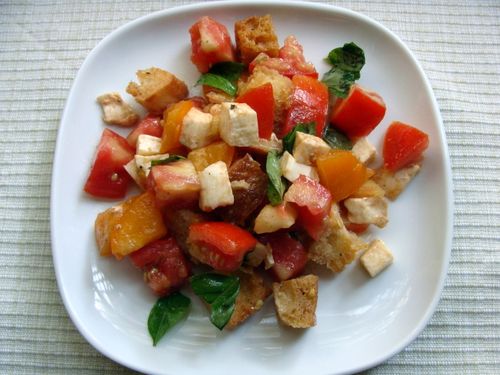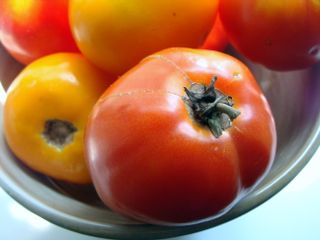Panzanella + thoughts on the Northeast late blight

As you all know, I finally started a real vegetable garden this year. I've determined that while I'm quite adept at killing other plant life, the eggplant, snow peas, collard greens, basil, celery, and jalapenos have escaped my grim reaper thumb. Then this late blight hits the Northeast in astonishingly lightening speed. So far my plants look okay, but I'm watching them closely. Like many people this year, I'm a first time gardener. I never expected to grow enough to feed my family for the season. My real intent was to complete the farm to table cycle. I'd always respected farmers for the long hours and hard work. Some crops are naturals, like my snow peas. They grow fast and plentiful. Others you have to sit and patiently watch and wait. It really does humble you and deepen your respect for nature.
Last night I read Dan Barber's op-ed in the NYT about late blight. There are many ways to say things and get your message across but the delivery (read: choice of words) affects how the reader interprets the message. I think the work Barber has done for the local food agenda is amazing but something didn't rest easy with me though when I read this passage:
"For starters, if you’re planning a garden (and not growing from seed — the preferable, if less convenient, choice), then buy starter plants from a local grower or nursery. A tomato plant that travels 2,000 miles is no different from a tomato that has traveled 2,000 miles to your plate."
Barber's point is absolutely right but here's how I would've said it:
"For starters, if you’re planning a garden (and not growing from seed — preferable but a bigger time commitment), then buy starter plants from a local grower or nursery. A tomato plant that travels 2,000 miles has the same ecological impact as a tomato that has traveled 2,000 miles to your plate."
The point is the same but one way sounds a bit condescending, while the other acknowledges the effort but explains the bigger picture. I didn't start my tomato plants from seeds not because it wasn't convenient, but because I had no place indoors to protect them from the fluctuating temperatures (and Sam the cat in his heyday). Instead I bought my plants from a local nursery and the Greenmarket. That doesn't mean the people who bought plants from Home Depot or Lowe's were intentionally trying to cause an epidemic. They simply didn't know any better. How about explaining why the plants from 2,000 miles are no different than to just whip out a tort remark.
I put it out to twitterverse asking other people's reaction. Did anyone else think Barber was being too hard on home gardeners? Another writer who I follow on twitter and hold in very high regard said it's not the time to be polite and that the situation could've been catastrophic. I'm not 100% convinced on that viewpoint. If we are to cultivate this movement and encourage people to understand the impact we have on our planet and food supply, it's important to understand the audience we're trying to attract, not the devout followers.
I've had the chance to connect with many people, good people, who are just learning the tenets of a Pro Food philosophy. As with everything in life it takes baby steps. Yes, the late blight situation is very serious in the Northeast, but as Barber notes two-thirds of the way into his article, the real blame lies in the budget cuts made to cooperative extension (more field agents might have helped to identify and contain the severity) and stores that are not being diligent in removing infected plants.
It's time the movers and shakers in the Slow Food campaign start understanding you get more bees with honey (I know poor choice of insect given the CCD problem). Create a discussion and talk with people not down to them. I'm convinced motherhood has made me this sensible. Lord knows six years ago I had no patience for what I deemed silly questions or not understanding something that was so evidently crystal clear. At the heart of it, Barber and I on the same page. Becoming a gardener does thrust one into a larger agricultural system and there are responsibilities to consider. I would've just plated the words in a more appealing fashion.

Post Note: Last night I was thinking more about the op-ed, and realized something important I didn't include in this post. For decades, processed food has been encroaching on the amount of real foods Americans consume. While we started as hunters and gathers a long time ago, getting back in touch with our food supply is almost like starting anew. There will unfortunately be some mistakes chalked up to trial and error. Hopefully the more sophisticated lines of communication that exist today will help contain the mistakes before they become catastrophic. To outright blame home gardeners and frighten them back into the conventional food chain would be taking two steps backwards.
Panzanella
Serves 4 as an appetizer (or one very hungry recipe tester at lunch time)
This Italian bread salad is a good way to use up day (or even two-day) old bread. Make sure to ask your local farmer about their practices and method to deal with late blight. Personally, it's worth it to spend a little more to ensure chemical-free tomatoes (I found some for only $2.50 a pound at Alex Farms, a vendor at the Carroll Gardens' Greenmarket). And if the price is too steep, then skip them and bookmark this recipe for next year.
4 1/2-inch thick slices of stale ciabatta or other stale crusty bread
3 medium-large tomatoes, coarsely chopped
3 ounces fresh mozzarella, diced
1 tablespoon extra virgin olive oil
1 1/2 tablespoons balsamic vinegar
Salt and freshly ground pepper, to taste
handful of fresh basil leaves
Preheat oven to 400ºF. Cut bread into cubes and place on a rimmed baking sheet. Bake until toasted and golden, about 5 minutes.
Meanwhile, add tomatoes and mozzarella to a medium bowl. Pour in oil and vinegar and toss to coat well. Season with salt and pepper. Tear basil leaves (or slice into a chiffonade if you want to show off your knife skills) and toss with tomato mixture. Let sit 10 minutes to release juices and let flavors marinate.
Add bread cubes to the tomato salad. Toss well and let stand to soak up juices, just a minute or two tops. Evenly divide onto four plates and serve immediately.



Related Links

Jessie
I wish I had a vegetable garden but I live in apartment complex. that bread salad looks really light and refreshing, which is perfect for the heat wave we’ve been having
Jen @ My Kitchen Addiction
The panzanella sounds tasty! I haven’t had too much luck with my tomatoes this summer, but I am hopeful still. I saw one or two just starting to turn orange/red yesterday.
Tina Marie
This is a beautiful photo and the recipe looks great. It’s a summery thing I think I’ll try. thank you for sending me your post.
Andrea@WellnessNotes
I so agree, choice of words is so important, especially when you want to get your point across to those who are skeptical. I love how you re-wrote Barber’s words about late blight.
I have grown my own tomatoes for many years, and I admit that I used to buy plants that had probably traveled thousands of miles. I have become a lot more conscious over the years (and I also had to get over my own rebellion towards my parents who grew everything and basically raised me thinking one meal at a fast food restaurant would kill me. Let’s just say that those messages really backfired for a while…).
I think anyone who is moving from eating processed food to growing their own food deserves encouragement. There is nothing wrong with wanting to educate people, but alienating them is very wrong and certainly won’t help.
Now to your beautiful bread salad. I haven’t made panzanella yet this year. It’s about time! Your recipe sounds wonderful.
Selfish Mom
Well said. I don’t tend to listen well when I’m getting defensive. And I don’t like being slapped around when I’ve made half an effort – the people making zero effort wouldn’t even be reading his remarks.
BTW, this looks like another great recipe to try my spicy basil in.
Chef Gwen
You make some great points about how to communicate (and encourage, not discourage) people about the benefits and sheer joy of eating locally grown food.
And, panzanella is probably my all time favorite summer salad. Thanks for sharing.